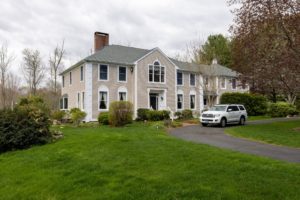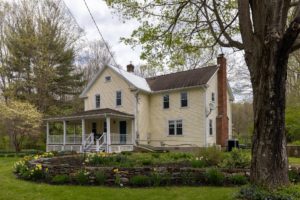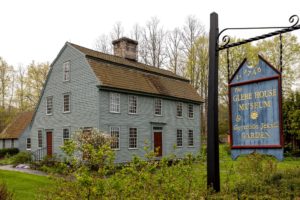Settled in the late 1600s, this Litchfield County town is more densely populated than its neighbors, with a quaint downtown and more full-time residents.
Shortly before the pandemic, Brad and Courtney Akin began hunting for a weekend getaway from their two-bedroom rental in Queens. It wasn’t long before they fell in love with a converted barn and grain silo, built in 1800, in the town of Woodbury, Conn., on the southern edge of Litchfield County. By the time they closed on the property, Covid-19 was raging, so they crammed what they could carry from their apartment into a U-Haul and drove with their son, who was almost 2, to their new home. And that’s where they’ve spent much of their time since.
Mr. Akin, 36, is an associate business manager at a Manhattan-based financial services firm for musicians; Ms. Akin, 32, is a marketing manager for a media company in Manhattan. Both have been working remotely, happily ensconced in their 3,045-square-foot, four-bedroom post-and-beam house. They paid $370,000 for the property, which sits on 1.34 wooded acres. This spring, they tapped some of their maple trees to make syrup.
It’s not that they don’t miss New York and all the city offers. They have held onto their apartment, but as Ms. Akin put it, “Everything looks different now — this is our refuge.
Rustic beauty and peace are qualities that many Woodbury residents appreciate, whether they live there part-time or full-time. Barbara K. Perkinson, Woodbury’s first selectman, estimated that of the town’s roughly 9,700 residents, weekenders make up 10 to 15 percent.
What distinguishes the town from neighbors that are less densely populated and heavier on weekenders — specifically Roxbury and Washington — is its quaint downtown. Stretching about two miles, it is lined with mostly locally owned small businesses, shops and restaurants — some in plazas, some in restored antique homes. This area is part of what earned Woodbury its 2020 Reader’s Digest designation as Connecticut’s “most charming small town.”
Another aspect of Woodbury’s charm is its sense of history. Settled in the late 1600s, the town is infused with its past, evident in the numerous 19th-, 18th- and even 17th-century homes that pepper its leafy streets, and in the names of several of those streets that commemorate its founders.

The Akins have been pleased to find plenty of red hearts honoring health care workers and anti-hate signs planted on lawns, as well as an active “Justice Woodbury” Facebook page and a weekly Black Lives Matter rally downtown. “They’re there literally every Sunday,” Mr. Akin said of the rallies. “People drive by and honk their horns.”
“OK, maybe not everybody here votes the same way,” he continued, acknowledging a townwide voting record that skews Republican. “But this town cares.”
What You’ll Find
Shaped like a rectangle with a jagged eastern side, Woodbury is bisected from its southern border to its northeastern corner by Route 6, also known as Main Street South and Main Street North, and the site of the downtown corridor. The rest of the town is primarily residential, its roads meandering past three rivers — the Pomperaug, Weekeepeemee and Nonnewaug — and more than 3,000 acres of parks, preserves and farmland.
RaeAnn Walcott, Woodbury’s assessor, said the town has 3,477 single-family homes. In addition to the antique houses, they include 20th-century ranches, raised ranches and Capes, and, in a few subdivisions, large 21st-century colonials.

There are also 42 two-family homes and eight three-family homes, plus 712 condominiums in seven complexes, among them the 400-unit Woodlake. There are 31 rental buildings, most with four to 12 units; the two largest have 56 and 74 units.
What You’ll Pay
Pels Matthews, an agent with William Raveis Real Estate, said homes in Woodbury sell from the $100,000s for a one-bedroom condo, up to $2 million. “Most of the single-family houses on the market are between $350,000 and $1 million,” he said, noting that Woodbury doesn’t command the premium prices that Roxbury and Washington do. “There are some nice estates here, but there are no $5 million homes.”
As it is elsewhere, inventory is unusually low, and the market “is unbelievable,” said Timothy S. Drakeley, a broker at Drakeley Real Estate, with “significant activity in every price range.”
Bidding wars and over-asking-price sales have become common. Mr. Drakeley cited a house listed recently for $649,000: “We had three offers within three days, each one over $670,000.”

According to information provided and compiled by SmartMLS, Inc., as of May 3, there were 29 single-family homes on the market, from a 2,018-square-foot, three-bedroom 1760 colonial on 4.1 acres, listed for $195,900, to a 2,416-square-foot, four-bedroom 1845 colonial on 33 acres, with a pool and pool house, listed for $1.899 million. Three multifamily homes were available: a 906-square-foot two-bedroom for $368,500; a 2,434-square-foot two-bedroom for $449,900; and a 5,600-square-foot five-bedroom for $724,900. One condominium was on the market, a 546-square-foot one-bedroom, for $125,000, as was one rental, a 3,159-square foot, four-bedroom house, for $18,000 a month.Prices are up across the board. The median sale price for a single-family home during the 12-month period ending May 3 was $392,500, up from $356,000 during the previous 12 months. The median price for a multifamily home was $313,750, up from $277,500. The median sale price for a condominium was $145,000, up from $127,500. And the median monthly rental was $1,500, up from $1,400.
The Vibe
Because of its variety of housing, Woodbury is more socioeconomically diverse than many of its Litchfield County neighbors. Mr. Drakeley, a lifelong resident, said the community is a mix of families who have stayed for generations and transplants from New York City, Westchester County and more built-up places nearby, like Southbury, Watertown and Waterbury. Ms. Perkinson described Woodbury as having “a hometown feel, where everybody knows everybody.”

Residents might bump into one another downtown, at the Canfield Corner Pharmacy or the popular New Morning Market and Vitality Center, one of two supermarkets in town. They might grab a craft beer at Woodbury Brewing Company or see a play at the nonprofit Community Theatre at Woodbury (once post-pandemic performances resume).Outdoor enthusiasts can explore the trails in several town-owned parks, including Hollow Park, with ball fields and a path along the Pomperaug River, and Orenaug Park, which has a rock-climbing section and an observation tower. Or they can hike to the scenic Nonnewaug Falls or wander in the 2,400-acre Flanders Nature Center and Land Trust, which maintains seven nature preserves, six of them in Woodbury. And for nearly three decades, Woodbury has held one of the state’s largest Earth Day celebrations (this year, it was a pandemic-safe hybrid version).
The town has a longstanding reputation as the antiques capital of Connecticut, but with some of its antiques stores shuttering, that has shifted. Now some locals call it “Foodbury,” for its wealth of restaurants. Favorites include the farm-to-table Good News Restaurant and Bar; the historic 1754 House restaurant and tavern; and Dottie’s, a must-visit stop on doughnut tours.
The Schools
Woodbury is served by Regional School District 14, which also serves the adjacent town of Bethlehem. Of the district’s roughly 1,650 students, nearly two-thirds live in Woodbury.
Children in prekindergarten through fifth grade attend one of two schools: Mitchell Elementary School, in Woodbury, or Bethlehem Elementary School, in Bethlehem. Enrollment in prekindergarten, an integrated special education program for 3- and 4-year-olds, is determined by lottery, and tuition is charged.

Students in sixth through eighth grade go to Woodbury Middle School before moving on to Nonnewaug High School; both schools are in Woodbury. Last fall, a three-year, $64 million renovation was completed at the high school, which includes the acclaimed Ellis Clark Regional Agriscience and Technology Center.
Data from the Connecticut State Department of Education’s Edsight portal indicated that on the 2018-19 Smarter Balanced assessments, 67.7 percent of the district’s fourth grade students were proficient in English language arts and 69.7 percent were proficient in math; statewide equivalents were 54.6 percent and 52.5 percent. Mean SAT scores for the 2020 graduating class were 528 in evidence-based reading and writing, and 512 in math, aligned with the College Board’s statewide means of 527 and 512.
The Commute
Woodbury residents might commute to nearby cities like Waterbury, a little more than 10 miles east; Danbury, 22 miles southwest; Torrington, 25 miles northeast; New Haven, 25 miles southeast; or Hartford, 41 miles northeast.
The commute to Manhattan, more than 80 miles southwest, is a long one, although some make the trip a few times a week. Those traveling to the city can head to Interstates 84 and 684 for the drive, which takes less than two hours, depending on traffic. Or they can drive more than 30 minutes southwest into New York to catch Metro-North Railroad’s Harlem line at Brewster, where trains to and from Grand Central Terminal take 79 to 107 minutes. Round-trip fares are $40 peak, $30 off-peak and $437 monthly; presently, all trains are considered off-peak.

The History
In the middle of the 20th century, the area around Woodbury was a haven for a small group of Surrealist artists. Alexander Calder, whose work found influences in Surrealism, lived in Roxbury. André Masson had a home in New Preston, and Arshile Gorky lived in Sherman. The painter Muriel Streeter and her husband, Julien Levy, a dealer in Surrealist art, lived in Bridgewater. And shortly after they married in 1940, Yves Tanguy and Kay Sage settled in Woodbury.
Mr. Tanguy, who came to the United States from France, painted disquieting dreamscapes populated with biomorphic abstractions, while Ms. Sage, the daughter of a New York State senator, set her geometric forms and architectural imagery in desolate landscapes. In 1946, the couple bought a 19th-century farmhouse and barn on Old Town Farm Road and converted the barn into side-by-side studios. After Mr. Tanguy’s death in 1955, Ms. Sage remained there until she took her life in 1963. The home and barn still stand.
Origination: https://www.nytimes.com/2021/05/12/realestate/woodbury-connecticut.html




